Abstract
The present study was designed to determine whether reduced amino acid uptake in skeletal muscle during endotoxemia is due to associated hypotension or is caused by a factor present in plasma. Three series of experiments were performed. In the first series of experiments, mean arterial pressure (MAP), heart rate, and amino acid uptake in incubated soleus muscles were measured after intravenous injection of endotoxin (1 mg/kg) in male Sprague-Dawley rats (40 to 60 g). Amino acid transport was measured by determining intracellular uptake of [3H]-alpha-amino-isobutyric acid (AIB) during 2 hours of incubation. In the second series of experiments, hypotension was induced by bleeding and muscle amino acid uptake was measured. In the third series of experiments, whole plasma or a low molecular weight fraction (less than 10,000 d) of plasma from endotoxin-injected rats was added in vitro to incubated muscles and amino acid uptake was determined. One hour after injection of endotoxin, MAP was reduced from 80 +/- 2 mmHg to 54 +/- 4 mmHg (p less than 0.05). AIB uptake was reduced by 20% (p less than 0.05) 2 hours after endotoxin injection. When MAP was maintained at 50 mmHg for 1 hour by bleeding, no changes in muscle AIB uptake were noted. When plasma obtained from rats 2 hours after endotoxin injection was added to incubated soleus muscles, AIB uptake was reduced by 22%. This effect was duplicated by a fraction of endotoxic plasma containing substances with a molecular weight less than 10,000 d. The present results suggest that reduced muscle amino acid uptake during endotoxemia is not due to associated hypotension, but may be caused by a circulating factor(s) with a molecular weight less than 10,000 d.
Full text
PDF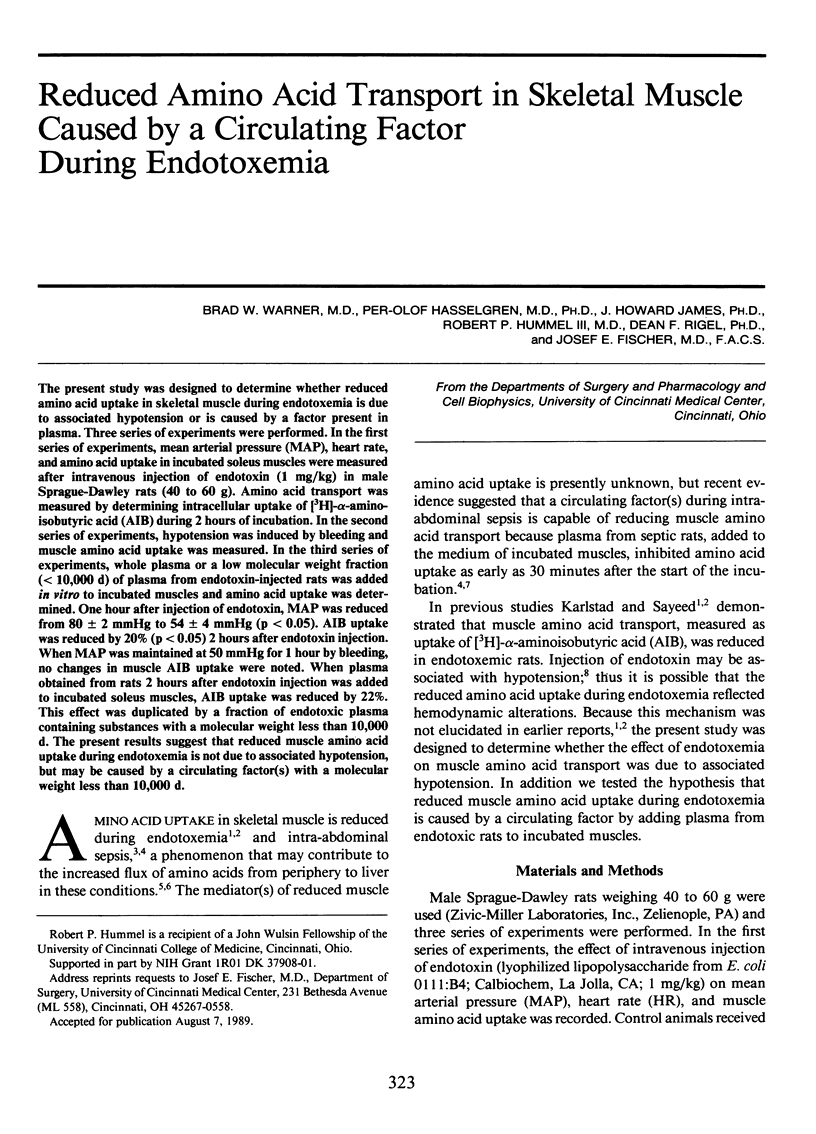
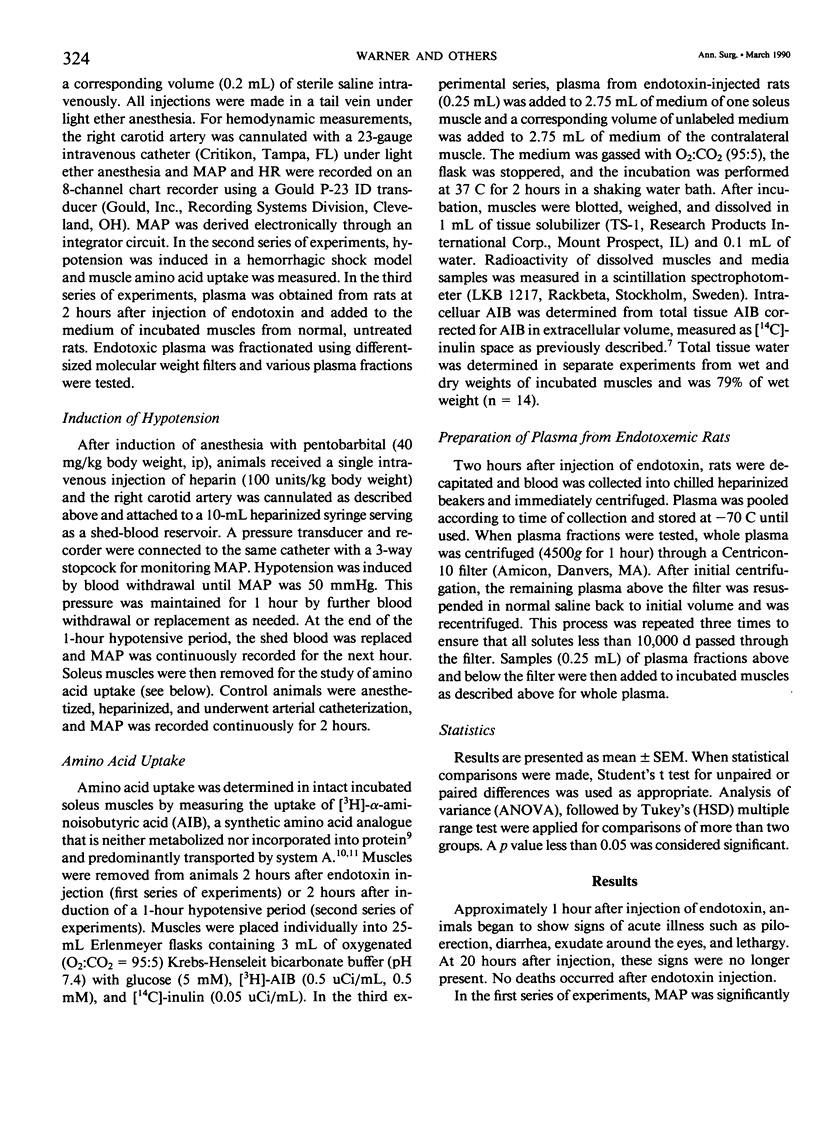
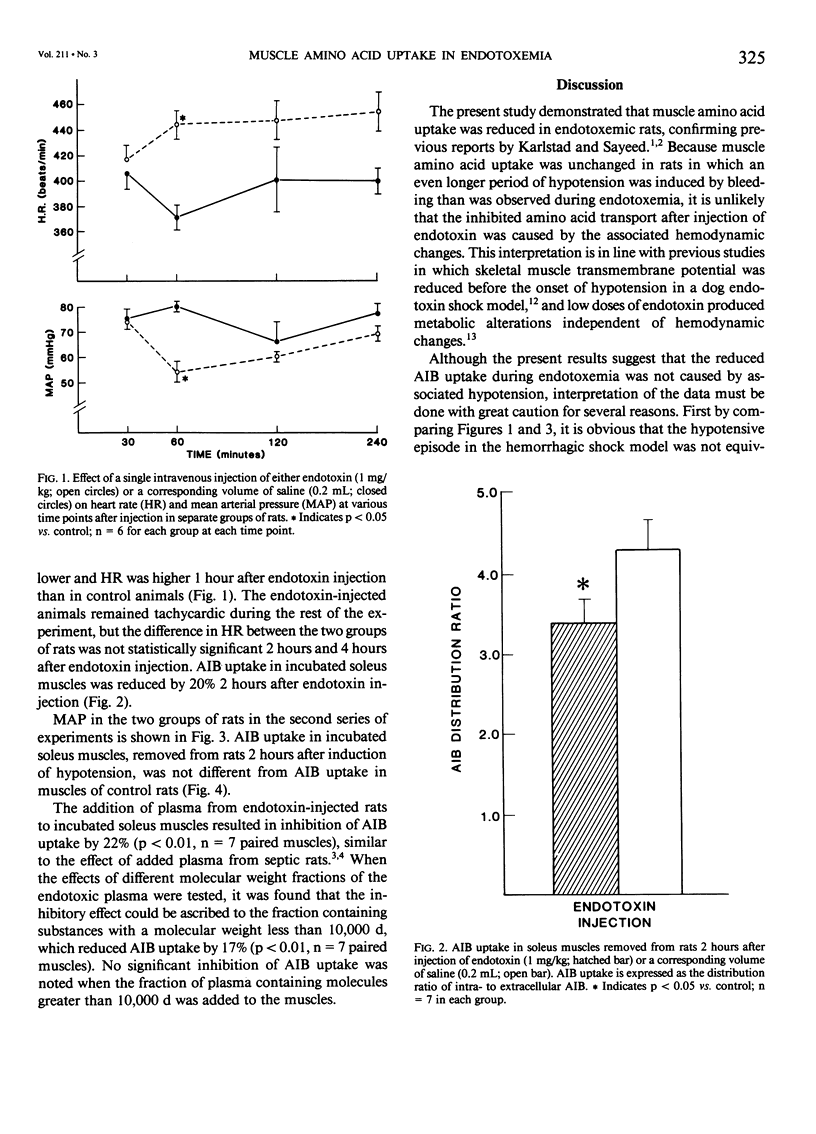
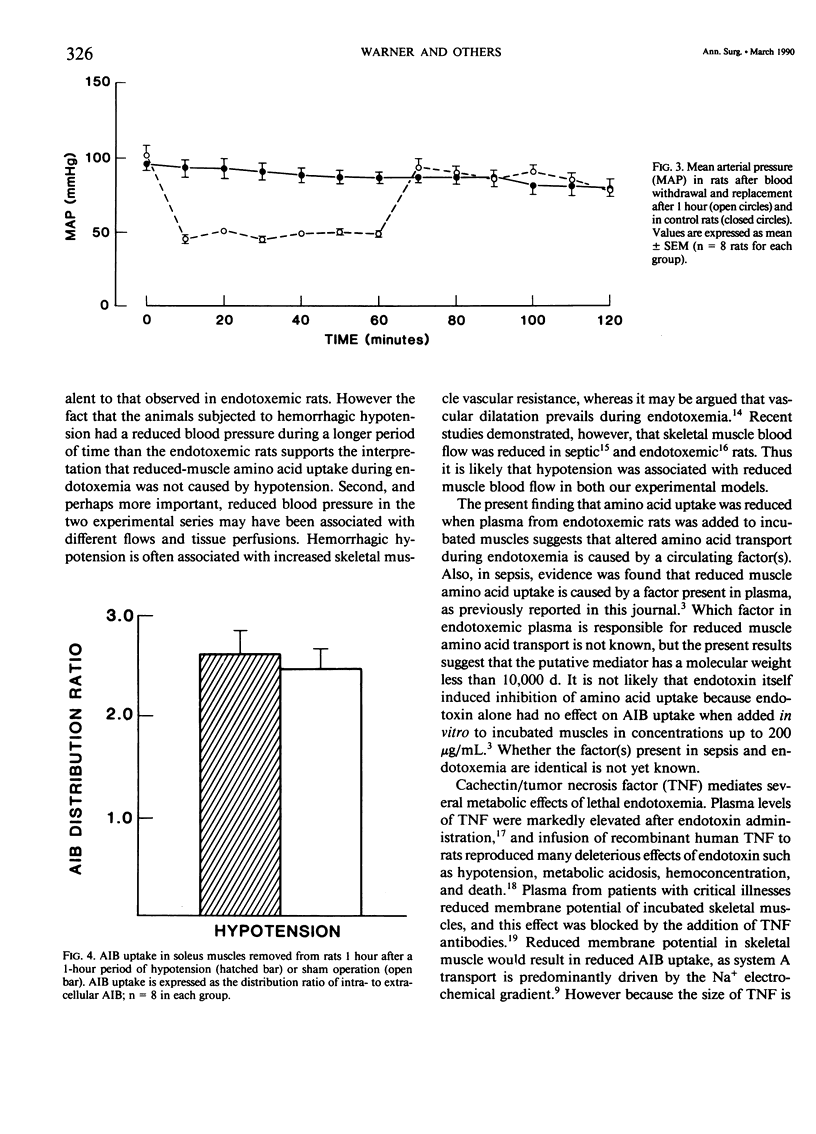
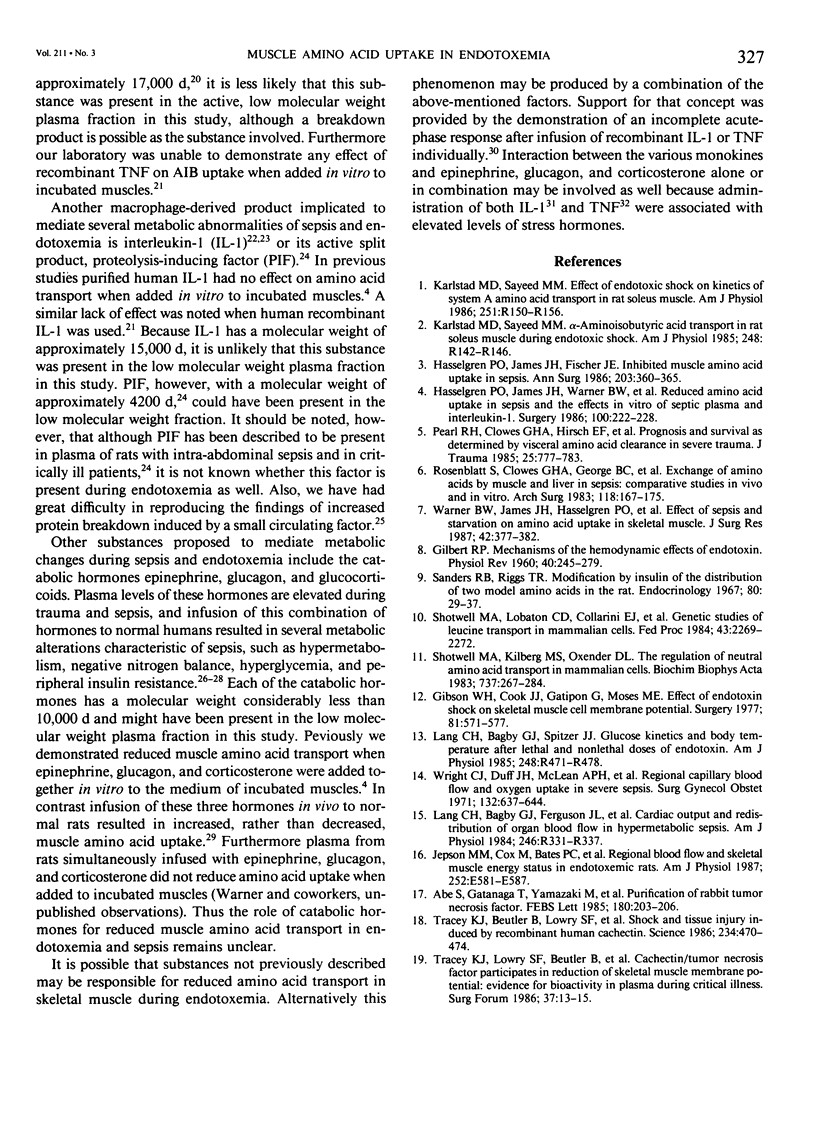
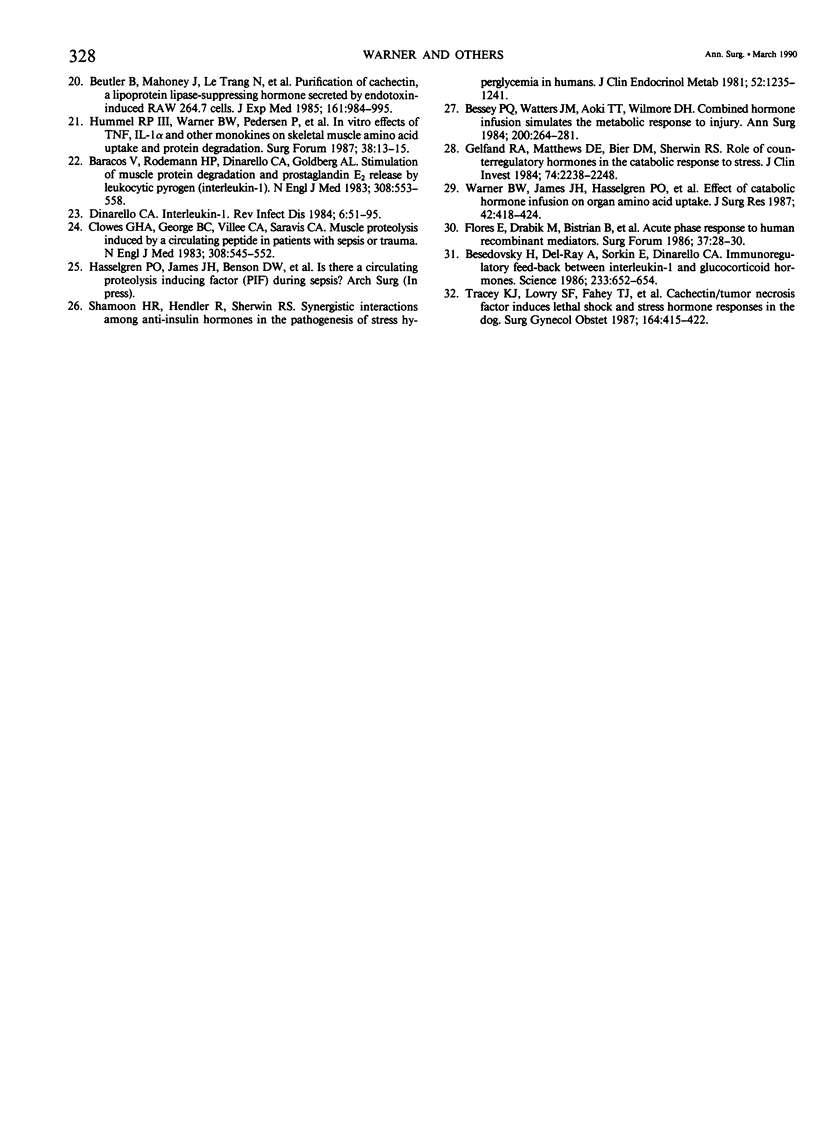
Selected References
These references are in PubMed. This may not be the complete list of references from this article.
- Abe S., Gatanaga T., Yamazaki M., Soma G., Mizuno D. Purification of rabbit tumor necrosis factor. FEBS Lett. 1985 Jan 28;180(2):203–206. doi: 10.1016/0014-5793(85)81071-1. [DOI] [PubMed] [Google Scholar]
- Baracos V., Rodemann H. P., Dinarello C. A., Goldberg A. L. Stimulation of muscle protein degradation and prostaglandin E2 release by leukocytic pyrogen (interleukin-1). A mechanism for the increased degradation of muscle proteins during fever. N Engl J Med. 1983 Mar 10;308(10):553–558. doi: 10.1056/NEJM198303103081002. [DOI] [PubMed] [Google Scholar]
- Besedovsky H., del Rey A., Sorkin E., Dinarello C. A. Immunoregulatory feedback between interleukin-1 and glucocorticoid hormones. Science. 1986 Aug 8;233(4764):652–654. doi: 10.1126/science.3014662. [DOI] [PubMed] [Google Scholar]
- Bessey P. Q., Watters J. M., Aoki T. T., Wilmore D. W. Combined hormonal infusion simulates the metabolic response to injury. Ann Surg. 1984 Sep;200(3):264–281. doi: 10.1097/00000658-198409000-00004. [DOI] [PMC free article] [PubMed] [Google Scholar]
- Beutler B., Mahoney J., Le Trang N., Pekala P., Cerami A. Purification of cachectin, a lipoprotein lipase-suppressing hormone secreted by endotoxin-induced RAW 264.7 cells. J Exp Med. 1985 May 1;161(5):984–995. doi: 10.1084/jem.161.5.984. [DOI] [PMC free article] [PubMed] [Google Scholar]
- Clowes G. H., Jr, George B. C., Villee C. A., Jr, Saravis C. A. Muscle proteolysis induced by a circulating peptide in patients with sepsis or trauma. N Engl J Med. 1983 Mar 10;308(10):545–552. doi: 10.1056/NEJM198303103081001. [DOI] [PubMed] [Google Scholar]
- Dinarello C. A. Interleukin-1. Rev Infect Dis. 1984 Jan-Feb;6(1):51–95. doi: 10.1093/clinids/6.1.51. [DOI] [PubMed] [Google Scholar]
- GILBERT R. P. Mechanisms of the hemodynamic effects of endotoxin. Physiol Rev. 1960 Apr;40:245–279. doi: 10.1152/physrev.1960.40.2.245. [DOI] [PubMed] [Google Scholar]
- Gelfand R. A., Matthews D. E., Bier D. M., Sherwin R. S. Role of counterregulatory hormones in the catabolic response to stress. J Clin Invest. 1984 Dec;74(6):2238–2248. doi: 10.1172/JCI111650. [DOI] [PMC free article] [PubMed] [Google Scholar]
- Gibson W. H., Cook J. J., Gatipon G., Moses M. E. Effect of endotoxin shock on skeletal muscle cell membrane potential. Surgery. 1977 May;81(5):571–577. [PubMed] [Google Scholar]
- Hasselgren P. O., James J. H., Fischer J. E. Inhibited muscle amino acid uptake in sepsis. Ann Surg. 1986 Apr;203(4):360–365. doi: 10.1097/00000658-198604000-00004. [DOI] [PMC free article] [PubMed] [Google Scholar]
- Hasselgren P. O., James J. H., Warner B. W., Ogle C., Takehara H., Fischer J. E. Reduced muscle amino acid uptake in sepsis and the effects in vitro of septic plasma and interleukin-1. Surgery. 1986 Aug;100(2):222–228. [PubMed] [Google Scholar]
- Jepson M. M., Cox M., Bates P. C., Rothwell N. J., Stock M. J., Cady E. B., Millward D. J. Regional blood flow and skeletal muscle energy status in endotoxemic rats. Am J Physiol. 1987 May;252(5 Pt 1):E581–E587. doi: 10.1152/ajpendo.1987.252.5.E581. [DOI] [PubMed] [Google Scholar]
- Karlstad M. D., Sayeed M. M. Effect of endotoxic shock on kinetics of system A amino acid transport in rat soleus muscle. Am J Physiol. 1986 Jul;251(1 Pt 2):R150–R156. doi: 10.1152/ajpregu.1986.251.1.R150. [DOI] [PubMed] [Google Scholar]
- Karlstad M. D., Sayeed M. M. alpha-Aminoisobutyric acid transport in rat soleus muscle during endotoxic shock. Am J Physiol. 1985 Feb;248(2 Pt 2):R142–R146. doi: 10.1152/ajpregu.1985.248.2.R142. [DOI] [PubMed] [Google Scholar]
- Lang C. H., Bagby G. J., Ferguson J. L., Spitzer J. J. Cardiac output and redistribution of organ blood flow in hypermetabolic sepsis. Am J Physiol. 1984 Mar;246(3 Pt 2):R331–R337. doi: 10.1152/ajpregu.1984.246.3.R331. [DOI] [PubMed] [Google Scholar]
- Lang C. H., Bagby G. J., Spitzer J. J. Glucose kinetics and body temperature after lethal and nonlethal doses of endotoxin. Am J Physiol. 1985 Apr;248(4 Pt 2):R471–R478. doi: 10.1152/ajpregu.1985.248.4.R471. [DOI] [PubMed] [Google Scholar]
- Pearl R. H., Clowes G. H., Jr, Hirsch E. F., Loda M., Grindlinger G. A., Wolfort S. Prognosis and survival as determined by visceral amino acid clearance in severe trauma. J Trauma. 1985 Aug;25(8):777–783. doi: 10.1097/00005373-198508000-00008. [DOI] [PubMed] [Google Scholar]
- Rosenblatt S., Clowes G. H., Jr, George B. C., Hirsch E., Lindberg B. Exchange of amino acids by muscle and liver in sepsis. Arch Surg. 1983 Feb;118(2):167–175. doi: 10.1001/archsurg.1983.01390020023004. [DOI] [PubMed] [Google Scholar]
- Sanders R. B., Riggs T. R. Modification by insulin of the distribution of two model amino acids in the rat. Endocrinology. 1967 Jan;80(1):29–37. doi: 10.1210/endo-80-1-29. [DOI] [PubMed] [Google Scholar]
- Shamoon H., Hendler R., Sherwin R. S. Synergistic interactions among antiinsulin hormones in the pathogenesis of stress hyperglycemia in humans. J Clin Endocrinol Metab. 1981 Jun;52(6):1235–1241. doi: 10.1210/jcem-52-6-1235. [DOI] [PubMed] [Google Scholar]
- Shotwell M. A., Kilberg M. S., Oxender D. L. The regulation of neutral amino acid transport in mammalian cells. Biochim Biophys Acta. 1983 May 24;737(2):267–284. doi: 10.1016/0304-4157(83)90003-5. [DOI] [PubMed] [Google Scholar]
- Shotwell M. A., Lobatón C. D., Collarini E. J., Moreno A., Giles R. E., Oxender D. L. Genetic studies of leucine transport in mammalian cells. Fed Proc. 1984 May 15;43(8):2269–2272. [PubMed] [Google Scholar]
- Tracey K. J., Beutler B., Lowry S. F., Merryweather J., Wolpe S., Milsark I. W., Hariri R. J., Fahey T. J., 3rd, Zentella A., Albert J. D. Shock and tissue injury induced by recombinant human cachectin. Science. 1986 Oct 24;234(4775):470–474. doi: 10.1126/science.3764421. [DOI] [PubMed] [Google Scholar]
- Tracey K. J., Lowry S. F., Fahey T. J., 3rd, Albert J. D., Fong Y., Hesse D., Beutler B., Manogue K. R., Calvano S., Wei H. Cachectin/tumor necrosis factor induces lethal shock and stress hormone responses in the dog. Surg Gynecol Obstet. 1987 May;164(5):415–422. [PubMed] [Google Scholar]
- Warner B. W., James J. H., Hasselgren P. O., Hummel R. P., 3rd, Fischer J. E. Effect of sepsis and starvation on amino acid uptake in skeletal muscle. J Surg Res. 1987 Apr;42(4):377–382. doi: 10.1016/0022-4804(87)90172-7. [DOI] [PubMed] [Google Scholar]
- Warner B. W., James J. H., Hasselgren P. O., LaFrance R., Fischer J. E. Effect of catabolic hormone infusion on organ amino acid uptake. J Surg Res. 1987 Apr;42(4):418–424. doi: 10.1016/0022-4804(87)90177-6. [DOI] [PubMed] [Google Scholar]
- Wright C. J., Duff J. H., McLean A. P., MacLean L. D. Regional capillary blood flow and oxygen uptake in severe sepsis. Surg Gynecol Obstet. 1971 Apr;132(4):637–644. [PubMed] [Google Scholar]


